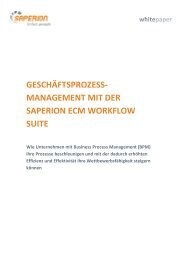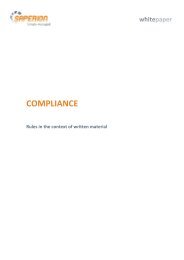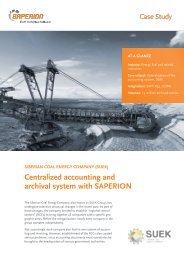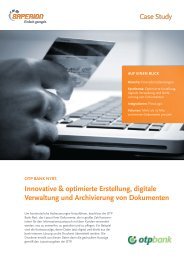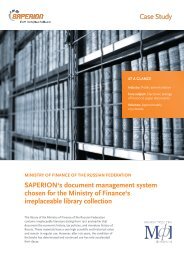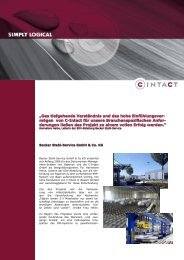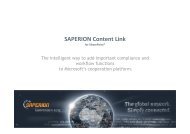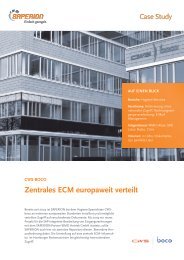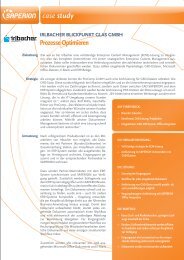4 a closer look at saperion ecm contract records - Saperion AG
4 a closer look at saperion ecm contract records - Saperion AG
4 a closer look at saperion ecm contract records - Saperion AG
Create successful ePaper yourself
Turn your PDF publications into a flip-book with our unique Google optimized e-Paper software.
SAPERION ECM CONTRACT<br />
RECORDS<br />
Electronic management of <strong>contract</strong> documents
Executive Summary<br />
EXECUTIVE SUMMARY<br />
The challenge<br />
Contracts are essential to modern business. They define virtually everything we do,<br />
whether insurance, leasing, rent, communic<strong>at</strong>ions, maintenance and service, or licenses.<br />
In most cases, two parties use <strong>contract</strong>s to define wh<strong>at</strong> shall be regul<strong>at</strong>ed<br />
and how as well as wh<strong>at</strong> amounts will be paid by whom. Contracts even define<br />
when and how the <strong>contract</strong> itself will become invalid. With th<strong>at</strong>, we have already<br />
mentioned two important <strong>contract</strong> terms th<strong>at</strong> must be kept in mind. In any case,<br />
<strong>contract</strong> terms must be observed by a variety of employees, particularly when a rel<strong>at</strong>ionship<br />
involves secondary agreements or penalties th<strong>at</strong> are applied when specific<br />
terms are not upheld.<br />
Various people in many different departments may close <strong>contract</strong>s. In many cases,<br />
these <strong>contract</strong>s are retained in paper form in multiple loc<strong>at</strong>ions. When other people<br />
require knowledge of the <strong>contract</strong>s, copies are cre<strong>at</strong>ed and distributed. To<br />
make things more complic<strong>at</strong>ed, <strong>contract</strong>s have a lifecycle and are subject to<br />
change. The upd<strong>at</strong>ed versions must then be redistributed.<br />
You can see already th<strong>at</strong> things can get very complic<strong>at</strong>ed very quickly. If termin<strong>at</strong>ion<br />
deadlines for building leases or software services are missed, the company<br />
may be forced to continue paying the charges. If the wrong version of a <strong>contract</strong> is<br />
referenced or if important inform<strong>at</strong>ion is missing, managers may make incorrect<br />
decisions and incur <strong>contract</strong>ual penalties. However, even the process of initi<strong>at</strong>ing a<br />
<strong>contract</strong> may gener<strong>at</strong>e documents th<strong>at</strong> could be relevant in a future legal dispute.<br />
For this reason, any associ<strong>at</strong>ed documents should be archived with the <strong>contract</strong><br />
from the very beginning.<br />
The importance of having the right solution<br />
Having a reliable <strong>contract</strong> management system enables optimized collabor<strong>at</strong>ion<br />
with customers and partners from both legal and str<strong>at</strong>egic perspectives, allowing<br />
the firm to avoid unnecessary risks. This white paper describes how employees of<br />
your organiz<strong>at</strong>ion can use SAPERION ECM Contract Records to handle these tasks<br />
efficiently.<br />
Your employees depend on rapid and straightforward access to <strong>contract</strong>s, correspondence,<br />
proposals, decision document<strong>at</strong>ion, secondary agreements, notes,<br />
e-mails, and more as allowed by their access rights. The key to achieving this is to<br />
consistently optimize document handling processes from the moment a document<br />
is cre<strong>at</strong>ed and throughout its entire lifecycle. Wh<strong>at</strong>'s more, these processes must<br />
work irrespective of loc<strong>at</strong>ion, time, and d<strong>at</strong>a form<strong>at</strong>.<br />
1
Executive Summary<br />
SAPERION ECM Contract Records provides time- and loc<strong>at</strong>ion-independent access<br />
to the tools needed to launch a uniform, global inform<strong>at</strong>ion system for all types of<br />
<strong>contract</strong>s. This makes SAPERION a highly effective way to support corpor<strong>at</strong>e <strong>contract</strong><br />
management.<br />
2
Table of content<br />
TABLE OF CONTENT<br />
1 Introduction to Contract Records 4<br />
2 Overview of benefits 7<br />
3 Requirements 9<br />
3.1 General requirements 9<br />
3.2 Requirements for regul<strong>at</strong>ory compliance 11<br />
4 A <strong>closer</strong> <strong>look</strong> <strong>at</strong> SAPERION ECM Contract Records 13<br />
5 Putting Contract Records into context 19<br />
6 Summary 21<br />
3
Introduction to Contract Records<br />
1 INTRODUCTION TO CONTRACT RECORDS<br />
It is not uncommon for companies to hold important inform<strong>at</strong>ion about <strong>contract</strong>s,<br />
<strong>contract</strong> terms, and agreements in both paper-based and electronic form. These<br />
same companies must make an early effort to minimize the costs associ<strong>at</strong>ed with<br />
managing and finding critical inform<strong>at</strong>ion, especially when dealing with complex<br />
agreements th<strong>at</strong> often pass through multiple phases of revision.<br />
For your employees to focus on truly important m<strong>at</strong>ters and make the best use of<br />
resources, they must have the ability to easily access <strong>contract</strong>s, correspondence,<br />
proposals, decision document<strong>at</strong>ion, secondary agreements, notes, e-mails, and<br />
even more. The key to achieving this is to consistently optimize document handling<br />
processes from the moment a document is cre<strong>at</strong>ed and throughout its entire lifecycle.<br />
Wh<strong>at</strong>'s more, these processes must work irrespective of loc<strong>at</strong>ion, time, and<br />
d<strong>at</strong>a form<strong>at</strong>.<br />
SAPERION ECM Contract Records provides technical support during all phases of<br />
the <strong>contract</strong> lifecycle, so you can concentr<strong>at</strong>e fully on organiz<strong>at</strong>ional tasks rel<strong>at</strong>ed<br />
to <strong>contract</strong> management:<br />
Planning <strong>contract</strong>s: Good <strong>contract</strong>s require careful planning. Planning involves<br />
not only ascertainment of objectives, but also assessment of <strong>contract</strong> risks,<br />
compil<strong>at</strong>ion of important inform<strong>at</strong>ion about the counterparty, the legal environment,<br />
and the object of the <strong>contract</strong>.<br />
Structuring <strong>contract</strong>s: Optimized <strong>contract</strong>s must be more than just clear and<br />
complete. They must also be structured properly and concluded in the right<br />
form.<br />
Negoti<strong>at</strong>ing <strong>contract</strong>s: Successful <strong>contract</strong> negoti<strong>at</strong>ions require thorough prepar<strong>at</strong>ion<br />
of both content and organiz<strong>at</strong>ion.<br />
Implementing <strong>contract</strong>s: Once <strong>contract</strong>s have been implemented and subsequently<br />
concluded, the next step is to define workflows and approval processes.<br />
Clear sign<strong>at</strong>ory and deputy rules are the most important components of the<br />
implement<strong>at</strong>ion process.<br />
Managing <strong>contract</strong>s: Each <strong>contract</strong> should be assigned to a "<strong>contract</strong> owner"<br />
who is responsible for maintaining the best possible document<strong>at</strong>ion of assigned<br />
<strong>contract</strong>s. Specific tasks may include expanding, adapting, and amending the<br />
<strong>contract</strong>s.<br />
Archiving <strong>contract</strong>s: Contracts must be classified according to how long they<br />
shall be retained, either in original or electronic form<strong>at</strong>.<br />
4
Introduction to Contract Records<br />
SAPERION ECM Contract Records provides all of the tools needed to launch a uniform,<br />
global inform<strong>at</strong>ion system for all types of <strong>contract</strong>s. SAPERION ECM Contract<br />
Records provides a comprehensive view of all <strong>contract</strong>-relevant inform<strong>at</strong>ion and is<br />
accessible from virtually any loc<strong>at</strong>ion and any time of day or night. This makes<br />
SAPERION a highly effective way to support corpor<strong>at</strong>e <strong>contract</strong> management.<br />
The benefits are described briefly below:<br />
Acceler<strong>at</strong>ed processes and the elimin<strong>at</strong>ion of copies and paper-based files save<br />
money.<br />
Having online access to relevant <strong>contract</strong> inform<strong>at</strong>ion boosts your ability to retrieve<br />
inform<strong>at</strong>ion.<br />
Efficient research options and convenient editing functions save additional<br />
time.<br />
Protection from unauthorized access to confidential inform<strong>at</strong>ion.<br />
Revision-proof archiving of <strong>contract</strong> documents and rel<strong>at</strong>ed correspondence increases<br />
security<br />
Managing all <strong>contract</strong>-relevant inform<strong>at</strong>ion<br />
SAPERION ECM Contract Records lets you initi<strong>at</strong>e <strong>contract</strong>s from directly within Microsoft<br />
Office and forward them electronically. Once the record it cre<strong>at</strong>ed, adding<br />
inform<strong>at</strong>ion like correspondence, decision document<strong>at</strong>ion, verbal and secondary<br />
agreements, notes, or e-mails is very convenient. As a result, the electronic record<br />
provides a complete picture of the situ<strong>at</strong>ion. Your company will also elimin<strong>at</strong>e the<br />
inconvenience of document copies and paper filing.<br />
The right inform<strong>at</strong>ion right now<br />
Contract-rel<strong>at</strong>ed inform<strong>at</strong>ion is retrieved through intuitive research forms. Inform<strong>at</strong>ion<br />
may be accessed by searching through indexed d<strong>at</strong>a, full-text searches, or<br />
the well-organized <strong>records</strong> navig<strong>at</strong>ion tool. As a result, inform<strong>at</strong>ion is available immedi<strong>at</strong>ely<br />
on the screen and processing st<strong>at</strong>us can be determined <strong>at</strong> any time.<br />
Easy-to-use processing functions for <strong>records</strong> and documents<br />
Convenient processing functions such as follow-ups, escal<strong>at</strong>ions, templ<strong>at</strong>e-based<br />
document gener<strong>at</strong>ion, completeness checks, favorites, bookmarks, and forwarding<br />
in workflows give you everything you need for rapid and efficient management of<br />
<strong>contract</strong> <strong>records</strong>.<br />
5
Introduction to Contract Records<br />
Traceability of decision-making processes<br />
Every change and step in the process is logged in detail. This makes it easy to quickly<br />
track the lifecycle and st<strong>at</strong>us of an agreement. As a result, there are fewer unnecessary<br />
questions and internal communic<strong>at</strong>ion is improved.<br />
Revision-proof archiving<br />
Fulfillment of compliance requirements for handling <strong>contract</strong>-relevant inform<strong>at</strong>ion<br />
is autom<strong>at</strong>ically supported, whether your first priority is revision-proof archiving,<br />
protection of sensitive d<strong>at</strong>a from unauthorized access, compliance with retention<br />
policies, or controlled destruction of d<strong>at</strong>a <strong>at</strong> the end of the lifecycle.<br />
Improved <strong>contract</strong> controlling<br />
SAPERION ECM Contract Records optimizes <strong>contract</strong> controlling. By maintaining a<br />
complete overview of the processes, content, and – especially – deadlines associ<strong>at</strong>ed<br />
with your <strong>contract</strong>s, you can avoid autom<strong>at</strong>ic oblig<strong>at</strong>ions. Evalu<strong>at</strong>ions help<br />
keep things organized as well as detect <strong>contract</strong>s th<strong>at</strong> require review, such as mobile<br />
phone <strong>contract</strong>s for employees who have left the company.<br />
Contract <strong>records</strong> vs. <strong>contract</strong> management<br />
A contact management system is a comprehensive solution for managing <strong>contract</strong>s.<br />
These systems primarily handle structured d<strong>at</strong>a. In contrast, SAPERION ECM Contract<br />
Records focuses on managing <strong>contract</strong> documents.<br />
In addition to managing structured d<strong>at</strong>a and providing extensive, graphical evalu<strong>at</strong>ion,<br />
<strong>contract</strong> management solutions usually include checklists for various types of<br />
<strong>contract</strong>s. These fe<strong>at</strong>ures provide support during the gener<strong>at</strong>ion process in order to<br />
keep quality high. Furthermore, ready-to-use <strong>contract</strong> templ<strong>at</strong>es for various industries<br />
are provided. Finally, a management solution commonly contains a viewer<br />
with functions for visually comparing versions of a <strong>contract</strong>, making it easy for parties<br />
to the <strong>contract</strong> to visualize changes.<br />
Evalu<strong>at</strong>ions, checklists, templ<strong>at</strong>es, and version-comparison functions are not part<br />
of the SAPERION solution, but can be provided on a case-by-case basis upon request.<br />
6
Overview of benefits<br />
2 OVERVIEW OF BENEFITS<br />
According to literary gre<strong>at</strong> Friedrich Schiller, "It is only by show of advantage th<strong>at</strong><br />
the world is governed. In this spirit, let's take a <strong>look</strong> <strong>at</strong> the advantages of launching<br />
electronic <strong>contract</strong> <strong>records</strong>.<br />
Reduce storage costs<br />
In most cases, this is the primary way th<strong>at</strong> electronic <strong>records</strong> reduce expenses. As<br />
with all <strong>records</strong> applic<strong>at</strong>ions, the elimin<strong>at</strong>ion of physical m<strong>at</strong>erials and expenses for<br />
renting storage space are the most obvious benefits of electronic <strong>contract</strong> <strong>records</strong>.<br />
Organiz<strong>at</strong>ions th<strong>at</strong> make the effort to protect their <strong>records</strong> from loss will also save<br />
additional expenses for backup copies. Electronic solutions can be designed for redundancy<br />
so all documents are retained <strong>at</strong> two different loc<strong>at</strong>ions and any changes<br />
are autom<strong>at</strong>ically mirrored to the other loc<strong>at</strong>ion. 1<br />
Shorter access times<br />
Electronic <strong>contract</strong> <strong>records</strong> cut down on expenses incurred when searching for<br />
documents. Index-based, full-text searching acceler<strong>at</strong>es access and elimin<strong>at</strong>es the<br />
need to physically walk to a filing cabinet.<br />
Continuous accessibility<br />
Obviously, <strong>contract</strong> <strong>records</strong> th<strong>at</strong> contain sensitive inform<strong>at</strong>ion should never simply<br />
lie around for everyone to see, but sometimes several people require access to the<br />
same file. In these situ<strong>at</strong>ions, electronic <strong>records</strong> elimin<strong>at</strong>e the hassle of chasing<br />
down physical files, since electronic <strong>records</strong> permit simultaneous access by several<br />
people. This is particularly valuable when team members work <strong>at</strong> several different<br />
subsidiaries. Quite simply, unavailability or even loss of important inform<strong>at</strong>ion is a<br />
thing of the past.<br />
No more copies<br />
Sometimes it is necessary to gener<strong>at</strong>e partial copies of a record, such as when preparing<br />
for off-site meetings. ECM elimin<strong>at</strong>es this hassle as well.<br />
1 It is important to note th<strong>at</strong> <strong>contract</strong> documents are characterized as official <strong>records</strong>. As a<br />
result, it is essential to perform a risk analysis before destroying originals. When in doubt,<br />
it is better to forgo destruction of any documents th<strong>at</strong> may be required in court in their<br />
original form. Accompanying documents, on the other hand, can normally be destroyed.<br />
7
Overview of benefits<br />
Nothing falls through the cracks<br />
Follow-up notific<strong>at</strong>ions help prevent important tasks from falling through the<br />
cracks. When things get done on time, employees and managers alike are less likely<br />
to become frustr<strong>at</strong>ed. The Favorites function ensures th<strong>at</strong> recently accessed <strong>records</strong><br />
can be quickly retrieved. Analysis functions identify missing documents th<strong>at</strong><br />
must still be acquired.<br />
Optimized d<strong>at</strong>a protection<br />
Having the ability to assign roles and deputies with differenti<strong>at</strong>ed access rights prevents<br />
viol<strong>at</strong>ion of d<strong>at</strong>a protection and privacy regul<strong>at</strong>ions. Logging provides traceability<br />
of who accessed certain d<strong>at</strong>a and when.<br />
Templ<strong>at</strong>es and versions<br />
"Is this the right version?" ECM elimin<strong>at</strong>es this uncertainty because it permits access<br />
to only the most recent version. As a result, unnecessary expenses for correcting<br />
mistakes are avoided. Using the most recent version is particularly important<br />
when managing document templ<strong>at</strong>es, for example.<br />
Compliance with retention directives<br />
Retention guidelines ensure th<strong>at</strong> specific types of documents will not be inadvertently<br />
destroyed, ensuring their availability in the event of a legal dispute. On<br />
the other hand, regul<strong>at</strong>ions sometimes require prompt destruction of other types<br />
of documents. Enterprise Content Management is also capable of handling this<br />
with little effort.<br />
8
Requirements<br />
3 REQUIREMENTS<br />
The following section describes several important requirements for effective management<br />
of <strong>contract</strong> <strong>records</strong>. In addition to these fundamentals, there are a number<br />
of other useful functions th<strong>at</strong> can support <strong>contract</strong> managers in their daily<br />
work. However, we will not discuss these here because they fall outside the<br />
framework of this white paper.<br />
3.1 General requirements<br />
The following requirements facilit<strong>at</strong>e general <strong>contract</strong> management.<br />
Records functions: Filing plan and graphical file folders<br />
A preconfigured filing plan ensures th<strong>at</strong> the same filing structure is used every time<br />
a new record is cre<strong>at</strong>ed. This helps ensure th<strong>at</strong> documents can always be found in<br />
the expected loc<strong>at</strong>ion. Users retrieve <strong>records</strong> by navig<strong>at</strong>ing through file folders, using<br />
a content-based full text search, or an advanced search function th<strong>at</strong> utilizes<br />
the existing index fields. The record's cover sheet contains pertinent inform<strong>at</strong>ion<br />
shared by all of the documents in the record. Favorites and bookmarks help the user<br />
quickly find <strong>records</strong> and documents th<strong>at</strong> are currently being processed.<br />
Capturing new documents<br />
Documents received in the regular mail are scanned and captured as an electronic<br />
image. During filing into the appropri<strong>at</strong>e record, documents are enriched with additional<br />
<strong>at</strong>tributes th<strong>at</strong> will subsequently enable search-based retrieval. At the same<br />
time, users who are granted access to the document are identified.<br />
Granular access protection<br />
Unlike paper-based <strong>records</strong>, electronic <strong>records</strong> allow you to establish differenti<strong>at</strong>ed<br />
access authoriz<strong>at</strong>ions. For example, paper-based <strong>records</strong> require physical removal<br />
of sensitive d<strong>at</strong>a before viewing by unauthorized persons, but electronic <strong>records</strong><br />
enable the legal officer to simply remove read rights for the affected documents to<br />
prevent them from being displayed <strong>at</strong> all.<br />
9
Requirements<br />
Templ<strong>at</strong>e administr<strong>at</strong>ion<br />
Document templ<strong>at</strong>es acceler<strong>at</strong>e gener<strong>at</strong>ion of new documents, such as reply letters<br />
or form letters. The form letter function makes it incredibly easy to inform a<br />
select group of people about recent changes or amendments to a <strong>contract</strong>, for example.<br />
Process support, tasks, and escal<strong>at</strong>ions<br />
When tasks must be completed by a particular deadline, the task itself can be associ<strong>at</strong>ed<br />
with the relevant document. Reminders help ensure th<strong>at</strong> important tasks<br />
like yearly reviews, <strong>contract</strong> cancell<strong>at</strong>ions, or <strong>contract</strong> adapt<strong>at</strong>ions are completed in<br />
a timely manner.<br />
Administr<strong>at</strong>ors can use the process designer to graphically model and cre<strong>at</strong>e templ<strong>at</strong>es.<br />
This is useful for common processes like gener<strong>at</strong>ion and approval of a <strong>contract</strong><br />
or the previously mentioned review and change process. The legal officer can<br />
also initi<strong>at</strong>e ad hoc processes in the form of circul<strong>at</strong>ion lists.<br />
Once a process has started, she can determine the current st<strong>at</strong>us of a business case<br />
<strong>at</strong> any time simply by checking the workflow inbox. This provides a high level of<br />
transparency, since it is always possible to review the history and see how far a<br />
process has gone and the p<strong>at</strong>h it has taken.<br />
Reporting and completeness analysis<br />
It is often useful to gener<strong>at</strong>e st<strong>at</strong>istics for specific <strong>records</strong>. A simple example of this<br />
would be a report th<strong>at</strong> calcul<strong>at</strong>es total <strong>contract</strong> fees and c<strong>at</strong>egorizes them according<br />
to criteria like "building", "vehicles", or "printer" for each office or department.<br />
Gener<strong>at</strong>ing a report is as simple as selecting the desired Excel templ<strong>at</strong>e and<br />
pressing a button to fill it with d<strong>at</strong>a.<br />
Visual depiction of gaps in a record show the user whether a record is complete,<br />
i.e. whether it contains <strong>at</strong> least all of the mand<strong>at</strong>ory documents. Additionally, an<br />
analysis function is available for seeking out the missing documents, enabling the<br />
legal officer to take active steps to fill the gaps.<br />
10
Requirements<br />
3.2 Requirements for regul<strong>at</strong>ory compliance<br />
Of course, purely technical issues are not the only requirements for ensuring productive<br />
use of an electronic <strong>contract</strong> <strong>records</strong> solution.<br />
Contracts may contain confidential inform<strong>at</strong>ion. So n<strong>at</strong>urally having ways to protect<br />
sensitive inform<strong>at</strong>ion is essential. These range from revision- and falsific<strong>at</strong>ion-proof<br />
archiving of documents, to the fundamental requirement th<strong>at</strong> only truly authorized<br />
persons may access <strong>contract</strong> documents, to destruction of d<strong>at</strong>a in accordance with<br />
legal requirements.<br />
The following sections explore these aspects in gre<strong>at</strong>er detail, particularly in terms<br />
of legal found<strong>at</strong>ions.<br />
SAPERION ECM Contract Records<br />
facilit<strong>at</strong>es regul<strong>at</strong>ory compliance<br />
Proper storage<br />
Since the solution is based on SAPERION ECM, the overall solution complies with<br />
pertinent accounting regul<strong>at</strong>ions. Of course, this depends on configur<strong>at</strong>ion of relevant<br />
processes and description of those processes in the process document<strong>at</strong>ion.<br />
With these conditions in place, there is no reason not to destroy paper copies of<br />
documents th<strong>at</strong> accompany the <strong>contract</strong>. Signed <strong>contract</strong>s themselves, though,<br />
should probably be retained in paper form, depending on the results of a risk analysis.<br />
Protection from unauthorized access<br />
SAPERION ECM Contract Records includes differenti<strong>at</strong>ed access management fe<strong>at</strong>ures<br />
to protect against unauthorized viewing of <strong>records</strong>. This results in significantly<br />
higher security than is possible with paper-based depositories.<br />
One person <strong>at</strong> the company, the system administr<strong>at</strong>or, has global rights to access<br />
all of the d<strong>at</strong>a. Generally speaking, the system administr<strong>at</strong>or should be a highly<br />
trusted person <strong>at</strong> the company and his or her employment <strong>contract</strong> should contain<br />
relevant clauses th<strong>at</strong> regul<strong>at</strong>e this role. The administr<strong>at</strong>or controls access by determining<br />
which users or groups of users are included in access lists.<br />
11
Requirements<br />
Then, when a legal officer archives a document, he or she simply chooses the suitable<br />
access list for th<strong>at</strong> document. A variety of rights can be granted to several different<br />
people in a single access list. For example, the responsible officer may have<br />
read only access to all documents plus the ability to write to the associ<strong>at</strong>ed meta<br />
d<strong>at</strong>a. Team members who are responsible for completing certain tasks, such as<br />
maintaining devices or completing projects, may have read-only access to all d<strong>at</strong>a<br />
so they are always in the loop about the company's <strong>contract</strong>ual rights and oblig<strong>at</strong>ions.<br />
If the legal officer handling a record changes positions, the system administr<strong>at</strong>or<br />
must only adjust the affected access list, giving the new officer exclusive access to<br />
the relevant <strong>records</strong>.<br />
A company is in negoti<strong>at</strong>ions with another company about a corpor<strong>at</strong>e takeover.<br />
A <strong>contract</strong> document is titled, for example, "Takeover offer for Company<br />
X". In a situ<strong>at</strong>ion like this, it is not sufficient to prevent unauthorized persons<br />
from opening the document. Instead, these unauthorized persons shall not be<br />
able to detect th<strong>at</strong> such a document even exists, even if they search for documents<br />
with "Takeover" in their titles.<br />
A represent<strong>at</strong>ive example<br />
Sign<strong>at</strong>ure rules<br />
Once <strong>contract</strong>s have been cre<strong>at</strong>ed, you can define who may sign which <strong>contract</strong>s<br />
and which <strong>contract</strong>s require dual controls.<br />
Compliance with retention periods – <strong>records</strong> management<br />
Some d<strong>at</strong>a must be retained for specific periods of time. Electronic <strong>contract</strong> <strong>records</strong><br />
ensure th<strong>at</strong> such d<strong>at</strong>a will be protected from deletion. This means th<strong>at</strong> no one, not<br />
even the system administr<strong>at</strong>or, has the ability to prem<strong>at</strong>urely delete d<strong>at</strong>a in viol<strong>at</strong>ion<br />
of the stored retention guidelines. Other documents must be deleted after a<br />
certain length of time has elapsed. Electronic <strong>contract</strong>s <strong>records</strong> can autom<strong>at</strong>ically<br />
remove such documents from the system <strong>at</strong> the appropri<strong>at</strong>e time.<br />
Audits<br />
Electronic <strong>contract</strong> <strong>records</strong> can help your company prepare for audits by seamlessly<br />
recording all of the activities rel<strong>at</strong>ed to your documents. As a result, you will be<br />
able to prove who had access to the <strong>records</strong> and when, who modified meta d<strong>at</strong>a,<br />
as well as who added or deleted documents. Even changes to access lists are recorded.<br />
12
A <strong>closer</strong> <strong>look</strong> <strong>at</strong> SAPERION ECM Contract Records<br />
4 A CLOSER LOOK AT SAPERION ECM<br />
CONTRACT RECORDS<br />
This chapter introduces the most important functions in the Contract Records system.<br />
We start by taking a <strong>look</strong> <strong>at</strong> the basic divisions of the user interface.<br />
User interface<br />
The user interface of SAPERION ECM Contract Records reflects the <strong>look</strong> and feel of<br />
familiar Microsoft Office applic<strong>at</strong>ions. The upper section of the interface contains a<br />
menu ribbon with common functions.<br />
A navig<strong>at</strong>ion bar on the left side of the interface makes it easy to navig<strong>at</strong>e through<br />
a wide variety of applic<strong>at</strong>ions and file folders, similar to Windows Explorer.<br />
Both the menu ribbon and the navig<strong>at</strong>ion area can be collapsed in order to make<br />
the best use of space on smaller screens.<br />
The remaining sections are used to display user dialogs. If multiple applic<strong>at</strong>ions are<br />
open (as shown below), they will be divided into individual tabs. Clicking on one of<br />
the tabs brings th<strong>at</strong> applic<strong>at</strong>ion to the front.<br />
In the figure below, a <strong>records</strong> applic<strong>at</strong>ion for retrieving <strong>contract</strong>-specific documents<br />
is open. The results of the search are displayed in a list of hits.<br />
User interface with menu ribbon<br />
and navig<strong>at</strong>ion and applic<strong>at</strong>ion<br />
areas<br />
The user can adjust the sizes of applic<strong>at</strong>ion dialogs to his individual requirements.<br />
13
A <strong>closer</strong> <strong>look</strong> <strong>at</strong> SAPERION ECM Contract Records<br />
Finding and opening a record<br />
At the most fundamental level, SAPERION ECM <strong>records</strong> solutions consist of two applic<strong>at</strong>ion<br />
dialogs: 1) a view of the entire collection of <strong>records</strong> and 2) a view of a selected,<br />
individual record.<br />
The tabular view of all <strong>records</strong> (used to find and gener<strong>at</strong>e a list of <strong>records</strong>, including<br />
the record cover sheet) displays existing meta d<strong>at</strong>a for the selected record.<br />
Records search<br />
Once a list of <strong>records</strong> has been gener<strong>at</strong>ed, the user can refine the results in the<br />
search window above the list.<br />
Double-clicking on one of the listed <strong>records</strong> opens the applic<strong>at</strong>ion dialog for working<br />
with these <strong>records</strong>.<br />
14
A <strong>closer</strong> <strong>look</strong> <strong>at</strong> SAPERION ECM Contract Records<br />
The left-side navig<strong>at</strong>ion<br />
area may contain more<br />
than just the <strong>records</strong> applic<strong>at</strong>ion<br />
(depends on department<br />
associ<strong>at</strong>ion). For<br />
example, users with special<br />
responsibilities may be<br />
able to manage <strong>contract</strong><br />
templ<strong>at</strong>es or access lists.<br />
When tasks are pending<br />
within business processes,<br />
they are displayed in the<br />
task folders.<br />
Typical navig<strong>at</strong>ion<br />
The <strong>records</strong> view<br />
The applic<strong>at</strong>ion dialog for viewing or editing an individual record once again displays<br />
the cover sheet <strong>at</strong> the left. The top right section contains a search function for<br />
searching in specific fields or in the entire content via full text search. As documents<br />
are found, they are displayed in the middle of the window.<br />
The list's columns are individually adjustable in order to show the most important<br />
context <strong>at</strong> a glance. Displaying a document is as simple as double-clicking on the<br />
relevant line in the list.<br />
Cre<strong>at</strong>ing a New Record<br />
A new <strong>contract</strong> record can be cre<strong>at</strong>ed by selecting a function from a context menu<br />
in the navig<strong>at</strong>ion pane. The cover sheet dialog then opens to permit entry of the<br />
record's meta d<strong>at</strong>a.<br />
15
A <strong>closer</strong> <strong>look</strong> <strong>at</strong> SAPERION ECM Contract Records<br />
Records cover sheet dialog for<br />
entering meta d<strong>at</strong>a for a new<br />
record<br />
The dialog for entering <strong>contract</strong> d<strong>at</strong>a is divided into five sub-dialogs th<strong>at</strong> group logically<br />
connected metad<strong>at</strong>a with each other. The document itself is shown on the<br />
right side of the screen. The figure above shows the first sub-dialog "General", in<br />
which the internal <strong>contract</strong> number, any external <strong>contract</strong> number assigned by the<br />
counterparty, and the <strong>contract</strong> description are entered. The other entry fields are<br />
linked with <strong>look</strong>up tables in which the relevant values are managed. Altern<strong>at</strong>ively,<br />
the values are retrieved from other previously existing tables.<br />
The four additional dialogs record inform<strong>at</strong>ion about the "Counterparty"; closing<br />
d<strong>at</strong>es, deadlines, and any other "D<strong>at</strong>es" regul<strong>at</strong>ed in the <strong>contract</strong>; "Financial d<strong>at</strong>a"<br />
like the <strong>contract</strong> value and payment terms; and "Miscellaneous" items such as<br />
terms of liability. Of course, dialogs may be individually adapted and expanded.<br />
When cre<strong>at</strong>ing a new record, a preconfigured filing plan ensures filing structures<br />
will be as uniform as possible throughout the organiz<strong>at</strong>ion.<br />
16
A <strong>closer</strong> <strong>look</strong> <strong>at</strong> SAPERION ECM Contract Records<br />
Maintaining the filing plan<br />
The filing plan used to cre<strong>at</strong>e a record can be modified as needed. A standard filing<br />
plan is included with the install<strong>at</strong>ion of SAPERION ECM Contract Records. Of<br />
course, it can also be adapted to each company's specific requirements.<br />
Granting access rights / sign<strong>at</strong>ure rules<br />
The administr<strong>at</strong>or can use access lists to grant highly differenti<strong>at</strong>ed access rights to<br />
a document. A preliminary configur<strong>at</strong>ion gives the responsible person a straightforward<br />
way to grant or deny certain users access.<br />
Sign<strong>at</strong>ure rules are particularly important when managing <strong>contract</strong>s. For example,<br />
it may be necessary to define which persons in specific departments may approve<br />
<strong>contract</strong>s and which types of <strong>contract</strong>s require dual approvals.<br />
Establishing these rules is an important step when launching <strong>contract</strong> <strong>records</strong> because<br />
each company has unique requirements.<br />
In most cases, it makes sense to implement approval workflows for <strong>contract</strong> gener<strong>at</strong>ion<br />
because approval reviews sometimes discover critical points th<strong>at</strong> require revision<br />
of the <strong>contract</strong>. SAPERION ECM can be optionally equipped with a graphical<br />
editor for modeling more complex processes.<br />
Capturing new documents<br />
New documents may be scanned directly into the <strong>contract</strong> <strong>records</strong>. Similarly, files<br />
from an existing file system may be transferred into the record. Users who cre<strong>at</strong>e<br />
documents in Microsoft Office applic<strong>at</strong>ions have additional "Load from record" and<br />
"Save in record" functions within the relevant Office applic<strong>at</strong>ion.<br />
Documents may be enriched with index values immedi<strong>at</strong>ely upon capturing. Doing<br />
so helps ensure proper filing and subsequent retrieval with the search function.<br />
Of course, sometimes manual capturing is inconvenient. In these cases, documents<br />
captured by an external scanning service, for example, may be autom<strong>at</strong>ically imported<br />
into the SAPERION ECM Contract Records system.<br />
Working with the templ<strong>at</strong>e manager<br />
If the user decides spontaneously to gener<strong>at</strong>e a document within the context of the<br />
open record, he or she can call up the templ<strong>at</strong>e manager without leaving the record<br />
itself. Once the user selects the desired templ<strong>at</strong>e, the unfinished document is<br />
loaded into the Office applic<strong>at</strong>ion and – if defined in the document templ<strong>at</strong>e – filled<br />
with index d<strong>at</strong>a from the record. From there, it is a simple m<strong>at</strong>ter to finalize the<br />
document in Word (or another Office applic<strong>at</strong>ion), print the document, and then<br />
archive it directly into the record.<br />
17
A <strong>closer</strong> <strong>look</strong> <strong>at</strong> SAPERION ECM Contract Records<br />
Gener<strong>at</strong>ing professional documents<br />
SAPERION ECM Contract Records (like all SAPERION ECM solutions) can be expanded<br />
with a component for gener<strong>at</strong>ing document templ<strong>at</strong>es for outgoing mail. The<br />
user accesses centrally-administered text blocks as a found<strong>at</strong>ion for<br />
cre<strong>at</strong>ing these templ<strong>at</strong>es. The templ<strong>at</strong>es themselves are saved in the templ<strong>at</strong>e<br />
manager, ensuring th<strong>at</strong> everyone throughout the company always uses the current<br />
version of the templ<strong>at</strong>e. The component is based on Microsoft Word and works<br />
with SAPERION Office Integr<strong>at</strong>ion.<br />
Follow-ups<br />
Once the document has been sent, the user can schedule a follow-up in order to<br />
keep track of any replies. By checking a box in the subsequent dialog, an appointment<br />
and/or a task can be set in Microsoft Out<strong>look</strong> or Notes for the specified d<strong>at</strong>e<br />
and time.<br />
Evalu<strong>at</strong>ions<br />
One of the most important requirements of a <strong>contract</strong> <strong>records</strong> solution is having<br />
the ability to evalu<strong>at</strong>e <strong>contract</strong>s in order to determine which ones shall be termin<strong>at</strong>ed<br />
or modified. For example, it is not uncommon for a large organiz<strong>at</strong>ion to<br />
over<strong>look</strong> mobile telephone <strong>contract</strong>s and continue to make autom<strong>at</strong>ed payments<br />
even though the phones are no longer in service.<br />
In SAPERION ECM Contract Records, these types of evalu<strong>at</strong>ions are conducted using<br />
Excel templ<strong>at</strong>es. All types of Excel templ<strong>at</strong>es can be stored and l<strong>at</strong>er selected by<br />
the responsible person. Up-to-d<strong>at</strong>e d<strong>at</strong>a are retrieved from the system, processed,<br />
and displayed.<br />
18
Putting Contract Records into context<br />
5 PUTTING CONTRACT RECORDS INTO<br />
CONTEXT<br />
While an introduction to electronic <strong>contract</strong> <strong>records</strong> may be useful and important,<br />
<strong>contract</strong> <strong>records</strong> are only rarely implemented as an isol<strong>at</strong>ed and completely independent<br />
solution.<br />
Integr<strong>at</strong>ion with ERP or CRM solutions<br />
Employees <strong>at</strong> larger corpor<strong>at</strong>ions, in particular, very often use solutions th<strong>at</strong> support<br />
management of sales- and tax-relevant d<strong>at</strong>a. These "Customer Rel<strong>at</strong>ionship<br />
Management" or "Enterprise Resource Management systems from providers like<br />
SAP, Siebel, Microsoft, or DATEV serve as the lead applic<strong>at</strong>ion in such situ<strong>at</strong>ions. In<br />
these cases, electronic <strong>contract</strong> <strong>records</strong> act as a sort of electronic file folder from<br />
which the lead system retrieves d<strong>at</strong>a as needed. Nevertheless, the <strong>contract</strong> <strong>records</strong><br />
can be used effectively without the lead system. An employee of the company who<br />
wishes to view the file rarely needs access to the d<strong>at</strong>a stored in the CRM or ERP<br />
system. It is usually adequ<strong>at</strong>e for him or her to have a <strong>look</strong> into the "file folder".<br />
But how do new documents get into the record?<br />
Cre<strong>at</strong>ion of new <strong>contract</strong> documents or annexes must likewise proceed as seamlessly<br />
as possible. Employees commonly cre<strong>at</strong>e individual documents with Microsoft<br />
Word. Ideally, existing d<strong>at</strong>a like address, <strong>contract</strong> number, and title will be<br />
loaded directly into the Word templ<strong>at</strong>e, thereby relieving the employee of this<br />
task. Once the Word document is cre<strong>at</strong>ed, it can be archived directly into the relevant<br />
record so th<strong>at</strong> it is never without context. Put another way, there is never a<br />
time when it is simply "lying around" on a virtual desktop. Even documents cre<strong>at</strong>ed<br />
by third-party systems (such as invoices from SAP) can be autom<strong>at</strong>ically filed into<br />
the proper loc<strong>at</strong>ion of the correct record (very important!) without additional user<br />
interaction. In most cases, a unique identifier like an <strong>contract</strong> number is used to assign<br />
documents to the proper record.<br />
19
Putting Contract Records into context<br />
E-mail, et al<br />
These days, electronic media are rapidly squeezing out old paper-based forms of<br />
communic<strong>at</strong>ion. So it is essential to integr<strong>at</strong>e e-mails and their <strong>at</strong>tachments into<br />
electronic <strong>contract</strong> <strong>records</strong>. As with other types of documents, it is very important<br />
to first avoid media breaks wherever possible, i.e. avoid the need to print e-mail <strong>at</strong>tachments<br />
and file them manually. Secondly, maximizing the security of priv<strong>at</strong>e inform<strong>at</strong>ion<br />
is absolutely essential.<br />
SAPERION ECM Contract Records<br />
meshes with all processes<br />
Integr<strong>at</strong>ion into the existing IT infrastructure<br />
Although <strong>contract</strong> <strong>records</strong> can have elev<strong>at</strong>ed requirements for access protection, it<br />
is not practical to oper<strong>at</strong>e the system completely detached from the existing IT infrastructure.<br />
Employees in the various departments benefit when the electronic<br />
<strong>records</strong>' authoriz<strong>at</strong>ion system is based upon the enterprise-wide user directory.<br />
Then user accounts in the <strong>contract</strong> <strong>records</strong> system can be synced with a directory<br />
service like Active Directory Service (ADS) from Microsoft. This has several benefits.<br />
First of all, users have the convenience of logging in to the <strong>contract</strong> <strong>records</strong> with<br />
their enterprise-wide credentials (single sign-on). Secondly, organiz<strong>at</strong>ional inform<strong>at</strong>ion<br />
like manager/subordin<strong>at</strong>e rel<strong>at</strong>ionships can be imported directly into the<br />
<strong>contract</strong> <strong>records</strong>. If sign<strong>at</strong>ure rules are captured in these directories, they too can<br />
be adopted.<br />
20
Summary<br />
6 SUMMARY<br />
Switching to electronic <strong>records</strong> management can deliver significant value to any organiz<strong>at</strong>ion.<br />
First, electronic <strong>records</strong> drastically reduce expenses for physical storage<br />
space, which can be particularly high when documents must be retained in two different<br />
loc<strong>at</strong>ions for security purposes. Equally important are the shorter access<br />
times, avoidance of copies, and the lower risk of loss.<br />
Many useful functions like templ<strong>at</strong>e management, reminders, and workflows make<br />
daily tasks much easier and help ensure th<strong>at</strong> no important m<strong>at</strong>ters fall through the<br />
cracks. Ultim<strong>at</strong>ely, this gives the company more time for developing new business.<br />
Access-control functions ensure th<strong>at</strong> documents containing sensitive inform<strong>at</strong>ion<br />
can be viewed only by those people with the proper authoriz<strong>at</strong>ion.<br />
The items described above represent the baseline expect<strong>at</strong>ions for all employees<br />
(not just those in the legal department) working <strong>at</strong> a modern corpor<strong>at</strong>ion with an<br />
effective <strong>contract</strong> management system.<br />
In addition, electronic <strong>contract</strong> <strong>records</strong> must fulfill legal requirements rel<strong>at</strong>ed to<br />
d<strong>at</strong>a protection and compliance in general.<br />
In order to make the switch to electronic <strong>records</strong> management as easy as possible,<br />
SAPERION ECM Contract Records places a high priority on user friendliness by respecting<br />
common habits and thought processes associ<strong>at</strong>ed with the handling of<br />
paper-based <strong>records</strong>. This approach applies not only to the handling of <strong>records</strong><br />
themselves, but also to integr<strong>at</strong>ion of electronic <strong>records</strong> into the existing ERP and<br />
CRM solutions.<br />
Last but not least: Switching to electronic <strong>contract</strong> <strong>records</strong> makes a contribution to<br />
environmental protection by reducing the consumption of paper. This can be taken<br />
even farther by converting entirely to electronic mail and avoiding the use of paper<br />
printouts when communic<strong>at</strong>ing with <strong>contract</strong> partners.<br />
21
Disclaimer<br />
The inform<strong>at</strong>ion in this public<strong>at</strong>ion is provided by SAPERION <strong>AG</strong> and its group companies (collectively referred<br />
to as "SAPERION").<br />
The contents of this public<strong>at</strong>ion, including all figures, tables, and drawings, are the intellectual property<br />
of SAPERION. All rights reserved. Removal or alter<strong>at</strong>ion of copyright notices or trademarks is not permitted.<br />
Forwarding or reproduction of this public<strong>at</strong>ion or parts thereof, regardless of reason or form, is not<br />
permitted without the explicit written authoriz<strong>at</strong>ion of SAPERION.<br />
All device or program names or services of SAPERION used in this public<strong>at</strong>ion as well as corresponding<br />
logos are trademarks or registered trademarks of SAPERION in Germany and other countries. Some<br />
software and/or hardware products sold by SAPERION may contain components th<strong>at</strong> are the property of<br />
other manufacturers. The names of these products and services and any associ<strong>at</strong>ed company logos are<br />
registered trademarks of the relevant companies.<br />
Inform<strong>at</strong>ion contained in this public<strong>at</strong>ion may be changed without advance notice. Specific<strong>at</strong>ions in the<br />
text are nonbinding and are intended solely for inform<strong>at</strong>ional purposes. This public<strong>at</strong>ion may describe<br />
certain intended str<strong>at</strong>egies, developments, and functions and SAPERION is not obliged to pursue a particular<br />
product str<strong>at</strong>egy or product development. SAPERION assumes no responsibility for errors or<br />
omissions in this public<strong>at</strong>ion. SAPERION does not guarantee the accuracy or completeness of inform<strong>at</strong>ion,<br />
text, graphics, links, or other elements contained in this public<strong>at</strong>ion. This public<strong>at</strong>ion is provided<br />
without any warranty, whether explicit or implicit. This applies in part but not exclusively to a warranty<br />
of marketability and suitability for a particular purpose as well as a warranty of non-viol<strong>at</strong>ion of applicable<br />
law.<br />
SAPERION assumes no liability or guarantee wh<strong>at</strong>soever for damages of any type, including and without<br />
limit<strong>at</strong>ion direct, special, indirect, or consequential damages associ<strong>at</strong>ed with the use of this public<strong>at</strong>ion.<br />
This limit<strong>at</strong>ion does not apply to premedit<strong>at</strong>ion or gross negligence. Legal liability for personal damages<br />
or product liability remains unaffected. Any inform<strong>at</strong>ion th<strong>at</strong> may be referenced in this public<strong>at</strong>ion<br />
through provided links is not subject to the influence of SAPERION and SAPERION provides no warranty<br />
or endorsement wh<strong>at</strong>soever for third-party websites.
SAPERION is a manufacturer of Enterprise Content<br />
Management and Business Process Management<br />
software.<br />
Or put another way: we produce software th<strong>at</strong> can help you save money by digitizing<br />
and ultim<strong>at</strong>ely acceler<strong>at</strong>ing your paper-based processes. At the same time, our products<br />
ensure th<strong>at</strong> your documents will be archived over the long term in a legally<br />
compliant way.<br />
Sound interesting?<br />
Additional inform<strong>at</strong>ion is available on our website http://www.<strong>saperion</strong>.com<br />
Compliance simply managed – the movie<br />
http://www.<strong>saperion</strong>.com/simply-managed<br />
Additional inform<strong>at</strong>ion about <strong>contract</strong> <strong>records</strong><br />
http://www.<strong>saperion</strong>.com/solutions/<strong>contract</strong>-<strong>records</strong>/<br />
Contact<br />
SAPERION (Switzerland) <strong>AG</strong> Tel.: +49 30 600 61-0<br />
in der Luberzen 19<br />
Mail: intern<strong>at</strong>ional@<strong>saperion</strong>.com<br />
CH-8902 Urdorf-Zürich<br />
www.<strong>saperion</strong>.com<br />
V2/21. Juni 2013



